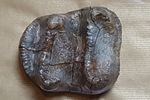Proboscidea
The proboscideans (Proboscidea) are an order of mammals that today includes three species within one family, the elephants: the African elephant, the forest elephant and the Asian elephant. The group was named after its trunk as the most conspicuous external feature. Other characteristics are found in the present-day representatives in the generally large and massive physique with columnar legs, the voluminous head and short neck, and the tusks, which developed from enlarged upper incisors. Recent elephants are distributed in the tropical regions of sub-Saharan Africa, South and Southeast Asia, as well as parts of East Asia, and use a variety of different landscapes. They live in complex social associations with herds of mothers and young as well as solitary males, which can sometimes form bachelor associations. There is complex communication between the individuals. The food consists mainly of plants, including grasses as well as leaves, fruits and the like. The exact composition varies with the seasons. As a rule, a young is born at intervals of several years and grows up in the herd.
The origin of the order goes back to the Paleocene about 60 million years ago. The oldest forms are known from northern Africa. These are still relatively small, partly aquatic animals without trunk and tusks. Both characteristics developed only later. In the course of the phylogeny different families developed, of which the Deinotheriidae, the Mammutidae, the Gomphotheriidae and the Stegodontidae are the best known. The families and their members reflect the diversity of the proboscideans. About 20 million years ago at the latest, the proboscideans reached Eurasia via a land bridge and spread out there. Some representatives migrated as far as America, so that the proboscideans had an almost worldwide distribution, with the exception of Australia, Antarctica and most islands far from the mainland. The animals adapted to a wide variety of habitats, ranging from tropical and densely forested areas of origin to high mountain landscapes and arctic open lands. Elephants represent the youngest member of the phylogenetic development and first appeared about 7 million years ago in the Upper Miocene. By the end of the Pleistocene, most of the proboscideans became extinct.
The scientific name of the proboscideans as Proboscidea dates from 1811. Initially, the group was associated with a wide variety of ungulates. An assumed closer relationship to the manatees and the sloths first appeared in the second half of the 19th century. This community, later known as Paenungulata, was subsequently substantiated skeletally anatomically as well as genetically and biochemically. Molecular genetics, in particular, established in the transition from the 20th to the 21st century that the proboscideans were more closely related to other originally African animals. The resulting kin group, which includes the Paenungulata as well as various insectivorous animals such as the proboscideans, the tenreciformes, and the aardvark, was therefore named Afrotheria. Outstanding work in the study of the proboscideans was done in the first third of the 20th century by Henry Fairfield Osborn.
Features
General and habitus
Today's proboscideans represent the largest land-dwelling animals. The body weight ranges from 2 to over 6 t with a shoulder height of 2 to 4 m. The animals are characterized by a massive build, a bulky head on a short neck and columnar legs. The most conspicuous external features are the extremely long trunk, which gives it its name, as well as the tusks and the large, lamellar grinders. The body is usually only slightly hairy. A special feature of the soft tissue anatomy is the temporal gland at the side of the eyes, which only occurs in elephants. In their phylogenetic past, proboscideans showed a rather high variability. The body size ranged from around 8 kg small animals from the earliest phase of the order to giant forms with up to 16 t body weight. With regard to body size and individual external characteristics such as the tusk shape, there is a clear sexual dimorphism in today's species, which can also be detected in some extinct forms.
Both the trunk and the tusks developed evolutionarily only gradually. As a common characteristic (synapomorphy) of all proboscideans, therefore, among other things, the generally enlarged central incisors of the upper row of teeth - from which the tusks later developed -, the loss of the foremost premolar, and tooth enamel prisms with a keyhole-like cross-section can be pointed out.
Skeletal features
Skull
As an anatomical feature, the very large head of the proboscideans has a skullcap interspersed with air-filled cavities. These honeycomb-like chambers, which are separated from each other by thin bone platelets, pass through the frontal, parietal and nasal bones as well as the central jawbone. They not only reduce the weight of the entire skull, but at the same time lead to an enormous increase in the volume of the skull surface. This increase in volume was necessary, on the one hand, to ensure the support of the head, including the evolutionarily ever larger tusks, by means of the powerful neck musculature, and on the other hand, to give the powerful masticatory musculature for the massive lower jaw an attachment surface. The development of such an air-filled skull began phylogenetically very early in the proboscideans and is proven in some representatives such as Barytherium already in the Oligocene, possibly also in the late Eocene.
The lower jaw of many early proboscideans is characterized by an elongated symphysis, which connects the two halves of the jaw at the front end. The elongation of the mandibular body often resulted from the formation of the lower tusks, whose alveoli were located laterally on the symphysis. As a result, these early proboscideans exhibit a more elongated facial region and can thus be considered longirostrine ("long-nosed"). In several lineages of proboscideans, such as the Mammutidae, the Gomphotheriidae, and the Elephantidae, shortening of the symphysis and thus of the facial region occurred later in phylogeny, usually associated with reduction of the lower tusks. These forms are called brevirostrine ("short snout").
Dentures
General
The original permanent proboscidean dentition still had the complete dentition of the higher mammals with 44 teeth consisting of three incisors, one canine, four premolars and three molars per jaw branch. Therefore, the following dental formula can be given for original proboscideans: 

Front dentition and tusks
The most striking skeletal element are the tusks, which today's elephants generally carry in the upper row of teeth. Many early representatives of the proboscideans also had tusks in the lower jaw. In the case of the Deinotheriidae and some other representatives, they were only found there. Their shape is very variable. They can be curved upwards or downwards, or they can be twisted, or they can be more or less straight, or they can have the shape of a shovel. Sometimes they stand close together or far apart. Also the length is different. In early proboscideans they were more like tusks, which protruded vertically from the top of the jaws, while in some mammoths and mammothids they were 4 to 5 m long. In principle, the tusks are formations of the incisors, which in the course of the phylogeny in connection with the general reduction of the number of teeth in the dentition of the proboscideans hypertrophied and thus grew to the largest teeth of all known extinct or still living animals. In this context, the upper tusks originated from the second incisor (I2) of each jaw branch, while the origin of the lower tusks has long been debated among experts, but has since been identified with the first incisor (I1) of the jaw branch. Exceptions are found, among others, in the Moeritheriidae, where the lower tusks also originated from the second incisors, while in the Barytheriidae each mandibular branch bore two tusks, so that a total of eight were formed. These corresponded respectively to the first two incisors of the mandibular arch. The gradual lengthening of the tusks during the ongoing tribal history also entailed functional changes. Today, elephants use their large tusks in a variety of ways, for example to help them feed, transport heavy objects, or fight rivals. Originally, however, the tusks probably served primarily for feeding. The vertical position of the upper row of teeth and the horizontal position of the lower row of teeth created a kind of scissors with which food plants could be cut.
Since the tusks of the proboscideans often show a relatively similar construction, an exact assignment is rather difficult with single finds. However, differences can be found in detail. Structurally, the tusks consist of three units. Inside is the pulp, the main growth zone. This is encased by the dentine, which makes up the majority of a tusk and corresponds to the actual "ivory". It is a mixture of carbonate-hydroxyapatite crystals bonded with collagen fibres. The former are mainly responsible for the hardness of the tusks, the latter for the elasticity. As a result, the dentine is highly mineralized and free of cells. It is formed in small tubules arranged radially around the center of the tusk. As a rule, these tubules have varying shapes, but abut each other at acute angles. The tubules closer to the center are usually larger than those at the edges. As a result, differences in density and absolute number of tubules occur within a tusk. In some cases, these tubules are interrupted by dentine ribs that run parallel to the tusk core. This general dentition structure shows individual variations within the proboscideans. Representatives of the Mammutidae, for example, have a higher proportion of denticle ribs towards the tusk core, whereas in the Gomphotheriidae and Elephantidae the tusks have a more homogeneous structure both near the pulp and towards the edge. It is unclear here which of the two represents the more original variant. The outer shell of the tusk is formed by a thin layer of tooth cementum. Here, too, there are individual variations between the different proboscideans. Especially in phylogenetically older lineages, a surrounding layer of enamel is often still formed, which surrounds the tusk in a band-like manner. In the Elephantidae, this enamel layer is usually missing completely.
The tusks of today's elephants possess as a further conspicuous feature an internal pattern of alternately light and dark colored areas. In the longitudinal direction of the tooth they form a band pattern, whereas in the cross-section of the tooth they are arranged like a chessboard. Due to the round shape of the tusk, the checkerboard pattern thus consists of rhombic surfaces with radial to tangential arrangement, which visually creates the impression of a complex spiral structure. The angles at which the rhombi abut each other differ between species and thus have taxonomic value. The pattern is called "Schreger lines" and is not known in mammals of other orders with tusk-like formations. The origin of the "Schreger lines" is controversial. According to different theories, they originate either from the arrangement of the dentary tubules or from the special orientation of the collagen fibers. Histological examinations could also prove the "Schreger lines" in other proboscideans like Anancus and Stegodon, which all belong to a closer relationship to elephants. Remarkably, however, they do not occur in phylogenetically older forms such as Deinotherium. Some researchers therefore assume that it is a unique feature of elephantoid proboscideans that evolved only once during proboscidean evolution. However, "Schreger lineages" have also been documented in Gomphotherium and Mammoth.
Rear dentition and change of teeth
For the systematic classification of the proboscideans, mainly the structure of the molars is used. The occlusal surface of these grinders is very diverse and adapted to the respective way of life of the animals. The most important basic types are the following:
| Different tooth forms of the proboscideans | |||
| Tooth type | Description | Examples | Photo |
| bunodont | Basic type of proboscidean teeth; the occlusal surface pattern consists of larger conical cusps, which are arranged in pairs transversely to the longitudinal axis of the tooth; in the middle of the longitudinal axis of the tooth a deep groove runs and divides the pairs in half; attached to the main cusps are small secondary cusps, the number of which can increase in the course of phylum development from two to four or more per half-groove; in addition, ridges and ridges occur, which sometimes obstruct the longitudinal groove; the arrangement of the cusps, secondary cusps and blocking ridges is partly irregular, in the chewed state a cloverleaf pattern is formed; phylogenetically younger proboscideans develop the bunodont pattern further, so the individual half ridges can be offset to each other ("anancoidia"), form a V ("chevroning") or numerous furrows and small cusps are formed ("ptychodontia" or "choerodontia") | early proboscideans like Eritherium and Saloumia, Moeritheriidae, Gomphotheriidae |
|
| zygodont | developed from the bunodont type; the cusps form a sharp ridge, the longitudinal groove is often not blocked by ridges and ridges; the secondary cusps are in line with the main cusps, resulting in straight yokes, some of which remain visible even when chewed; in general, zygodont molars are wider than bunodont ones | Mammutidae |
|
| lophodont | also evolved from the bunodont type; the conical cusps are intergrown by sharp ridges, which in turn are formed from a high increase in the number of accessory cusps | Numidotheriidae, Phosphatheriidae, Barytheriidae, Deinotheriidae Stegodontidae |
|
| lamellodont | again derived from the bunodont pattern; the tooth is formed from lamellar enamel folds; like the lophodont teeth, the enamel lamellae result from the increasing number of sinuses | Elephantidae |
|
In addition, there are individual transitional forms such as bunolophodont, bunozygodont or zygolophodont. The earliest proboscideans such as Eritherium possessed a bunodont pattern. The individual tooth forms then evolved independently within the various proboscidean lineages. As a result, ancestral forms of some lineages, such as Losodokodon in the Mammutidae, had even more distinct bunodont molars, from which the typical zygodont pattern of the late forms developed. The proboscidean molars can be derived from the originally tribosphenic teeth of the higher mammals, whose chewing surface is strongly topographically structured. The tribosphenic teeth consist of a raised area, called trigon in the case of maxillary molars and trigonid in the case of mandibular molars, on which the three main cusps are located. These main cusps are in turn called para-, proto-, and metaconus on the upper molars, and paraconid, protoconid, and metaconid on the lower molars; in numerous derivations from the tribosphenic basic structure of the grinders, a fourth cusp, the hypoconus, has been formed on the upper molars in many mammalian lineages, mostly independently. The trigone is followed by a lower section with the secondary cusps, which in turn forms the so-called talon in the maxillary and the talonid in the mandibular molars. On the lower jaw grinders, which are often more voluminous, the talonid bears some larger cusps, such as the hypoconid and entoconid. In the teeth of proboscideans the anterior part comprises the trigon or trigonid, and the posterior the talon or talonid. With respect to the maxillary molars, the anterior pair of cusps corresponds to the paraconus and protoconus with the protoloph as a transverse bar or yoke (on the mandibular molars, consequently, the protoconid and metaconid as well as the protolophid). The second pair of cusps is formed by the metaconus and the hypoconus, both connected by the metaloph (on the mandibular molars accordingly the hypoconid and entoconid as well as the hypolophid). The posteriorly following pairs of cusps then arise from the talon/talonid. A longitudinal groove, which runs centrally over the entire length of the tooth, divides the cusp pairs or ridges or yokes into two half ridges/half yokes each, the tongue-side area of which is called the entoloph (entolophid) and the cheek-side area is called the ectoloph (ectolophid). This is particularly evident in the bunodont and zygodont molars, but less so in the lophodont and lamellodont molars. However, all proboscidean molars thereby possess two tooth part surfaces, which are more or less worn due to the chewing mechanism of the animals. The more worn part is called pretrit, the weaker posttrit. In the upper jaw, the more strongly chewed part of the tooth is always formed on the tongue side, the less strongly on the cheek side. In the case of the mandibular molars, the situation is exactly the opposite.
Another distinctive feature is the increasing complexity and relative as well as absolute enlargement of the molars. The first two molars of the earliest proboscideans had a total of two pairs of cusps, i.e. were bilophodont (with two ridges or yokes). The third grinder often had three ridges, although the third was sometimes weakly developed. The cusps of the two (anterior) ridges correspond to the trigon and the trigonid, respectively. In the further course, the number of ridges on the first two molars initially increased to three, resulting in trilophodont teeth (with three ridges or yokes). This is also where differentiation of the two anterior molars from the posteriormost began, as the latter usually has a higher number of ridges, so initially between four and five (generally the posteriormost lower molar has more ridges than the posteriormost upper). The new additional pairs of cusps developed from the talon or talonid, respectively, each additional ledge representing in principle only a duplication of the preceding one. In modern elephants, this developed to the extreme, as, for example, within mammoths, the rearmost molar tooth can have up to 30 ridges. The molars of the more modern proboscidean lineages represent the largest among mammals, sometimes exceeding 20 cm in length and weighing more than 5 kg.
Today's proboscideans have high-crowned (hypsodont) molars, which means that the crown height of a molar clearly exceeds their width, sometimes by twice. The massive increase in crown height is an evolution of modern elephants and represents an adaptation to hard grass diets, favored by the spread of grasses during the Miocene. Nevertheless, some increase in crown height is also evident in individual older proboscidean lineages such as the Gomphotheriidae. However, the majority of the representatives of the proboscideans exhibited low-crowned, i.e. brachyodont, grinding teeth. A special feature of the evolved proboscideans is the formation of the enamel, which consists of three layers: an outer layer of radially oriented prisms, a middle layer of Hunter-Schreger bands (variably light or dark striped enamel bands with differently oriented prisms) and an inner layer of a three-dimensional network of interwoven prism bundles. Differences exist to the earliest proboscideans such as the Phosphatheriidae, the Moeritheriidae, or the Phiomiidae in which the enamel is usually composed of only two layers, often, but not in every case, the two upper layers. Differing from this, the teeth of the Deinotheriidae consist chiefly only of the interwoven prismatic bundles. Especially the latter formation is regarded as a special hardening stage of the enamel, whereby it can better resist the horizontally acting forces during the chewing process. Accordingly, in proboscideans the particularly hard variant of enamel developed well before the time when higher tooth crowns were formed, which can be interpreted as a type of preadaptation.
The change of teeth in today's elephants does not take place vertically as in most mammals, but horizontally. As a result, of the three premolars and three molars per jaw arch, usually only one to one and a half are in function at any one time. These erupted teeth are worn down considerably when chewing plant food. Meanwhile, new tooth material is formed in the rear part of the dentition, which is continuously pushed forward. Thus, when the elephants lose a tooth, a new one is available each time. This process can be repeated a total of five times after the eruption of the first deciduous premolar, which corresponds to six tooth generations (three deciduous premolars and three molars). The horizontal alternation of teeth resulted from the enlargement of the teeth due to the formation of additional ridges and from the shortening of the jaw in the course of proboscidean evolution, so that there was no longer room for all the teeth at the same time. This feature first appeared in the course of the Oligocene. Before this radical change, the proboscideans changed their teeth in a vertical mode comparable to other mammals. Accordingly, in these representatives all teeth of the permanent dentition were in function at the same time. The change of the dentition is possibly connected with a general change in the feeding behaviour and in the chewing process. The Deinotheriidae changed their teeth vertically, whereas the simultaneously occurring and almost equally large Gomphotheriidae changed their teeth horizontally. The latter had significantly larger teeth with more ridges compared to the former, which allowed for a wider range of food in terms of wear and the like.
Body skeleton
Particular skeletal anatomical features are the columnar limbs, which stand vertically under the body, with the upper and lower parts of the extremities forming an angle of 180°. This distinguishes the proboscideans from numerous other mammals whose legs are arranged at a slight angle. The distinctly vertical position, which was already fully developed in the Deinotheriidae, supported the enormous weight gain of the early representatives of this order. Primitive Eocene proboscideans such as Numidotherium and Barytherium possessed even more distinctly angled legs. In addition, the limbs with their long upper limb segments versus short lower ones show adaptations to heavy weight (graviportal). The ulna and radius are not fused, but fix each other when the foreleg is rotated. The femur is narrowed in front and behind. Furthermore, the long bones do not have a bone marrow cavity, but the space is filled with spongiosa, which gives the legs greater strength. Blood formation takes place in the spaces between the bones. The individual hand and tarsal bones are arranged serially, i.e. they do not overlap each other at the joint surfaces, but lie one behind the other (taxeopod). Forefeet and hindfeet usually have five rays each. As a further special feature of the feet, proboscideans have a sixth "toe", which attaches behind the thumb or big toe. The point of attachment is located at the upper (proximal), inward-pointing joint end of the metacarpus I (thumb) or metatarsus I (big toe) and consists of cartilage material that is partially ossified. It serves to support the other toes in stabilizing high body weight. The formations are called prepollex ("fore-thumb") on the forefoot and prehallux ("fore-toe") on the hindfoot, respectively. These can also be traced back to the early Miocene in the Deinotheriidae. The development of this anatomical peculiarity is related to the enormous increase in body size of the proboscideans at that time, which is connected with the departure from the rather amphibious way of life of the early Proboscidea representatives to a purely terrestrial one. This also changed the general foot position. Original proboscideans had more horizontally oriented foot bones and were functionally adapted to sole gait. In today's elephants, the toes form a semicircle and are more clearly oriented vertically. As a result, elephants can be considered toe-walkers. The sixth "toe" probably developed as a supporting element during the transformation of the foot anatomy and the simultaneous massive increase in body mass.
Soft Tissue Anatomy
Trunk
The most striking characteristic of the proboscideans is the proboscis, which develops from the adhesion of the upper lip with the nose and is already formed in the embryonic stage of today's elephants. At the lower end of the trunk, the two nasal passages emerge. It consists of up to 150,000 longitudinal, circular or oblique muscle fibres from a variety of different muscles and performs numerous functions as a sensitive prehensile organ. Primarily, it bridges the distance between the head and the ground, which the short neck of the animals cannot do. This makes it essential for feeding by tearing off plants growing on the ground or by taking up water and guiding it to the mouth. Conversely, it can also be used to reach higher objects such as leaves in the treetops. In addition, it serves as a respiratory and transport organ and also has great importance in social communication as a tactile and sensory organ. As a purely muscular formation, the proboscis occupies a larger part of the facial area of the skull. Its formation resulted in a massive restructuring and shortening of the bony substructure. This includes above all a clear reduction of the nasal bone, which mostly exists only as a short extension. In contrast, the nasal opening is extremely large. Due to the restructuring of the facial skull, the massive proboscis musculature was given large attachment points.
In fossil proboscideans, the presence of a proboscis can only be indirectly deduced from the facial anatomy, mainly the nasal region. Accordingly, the earliest forms probably did not yet have a proboscis. First signs of a proboscis are found in Numidotherium from the Lower to Middle Eocene. The development possibly started with only short, rather tapir-like proboscises, which emerged from a very mobile upper lip and only gradually lengthened in the course of the increase in body size. Also for the partly huge representatives of Deinotherium a rather short proboscis is assumed due to the high position of the nasal opening towards the upper side of the skull, but it must have been sufficiently long to reach the ground with it. Some researchers assume that the proboscis has evolved independently several times within the proboscideans.
Brain
The proboscideans belong to the few mammal groups in which a brain of more than 700 g was formed comparable to the primates and the whales. Today's elephants have a brain volume of 2900 to 9000 cm³. In relation to a body weight of 2.2 to 6.6 t, this corresponds to an encephalisation quotient of 1.1 to 2.2, the average value is 1.7. In comparison, the encephalisation quotient in humans is about 7.5. The structure of the elephant brain is complex. It consists of about 257 billion nerve cells, which is 3 times the amount compared to the human brain. In contrast to the human brain, 98% of the nerve cells in elephants are located in the cerebellum. In addition, the temporal lobe is more developed than in humans. The brains of extinct proboscideans have only rarely survived, except for a few ice mummies of the woolly mammoth (Mammuthus primigenius). From other fossil forms, information on the dimensions of the brain is only exceptionally available, which was then largely obtained from casts of the interior of the skull. Here it could be shown that in some dwarfed elephants, such as the Sicilian dwarf elephant (Palaeoloxodon falconeri), a comparatively large brain was formed, reaching about 1800 cm³ at a body weight of 190 kg, resulting in an encephalization quotient of about 3.75.
The oldest known cranial effusion belongs to Moeritherium, which belongs to the transition from the Upper Eocene to the Lower Oligocene. Its brain volume was estimated at 240 cm³, with a presumed body weight of 810 kg. The encephalization quotient can thus be given as about 0.2. A proportionally comparable relationship between brain size and body weight was developed in Palaeomastodon, which was about the same age. Its brain volume was 740 cm³, the body weight was 2.5 t and the encephalisation quotient was 0.3. The brain volume then gradually increased in the course of the phylogeny, which obviously took place parallel to the increase in body weight. However, a faster brain growth compared to body size can be observed, as the encephalization quotient also increased. However, this did not occur at the same rate in all lineages of proboscideans. The Mammutidae, which form a relatively original lineage within the proboscideans but appeared at about the same time as modern elephants and did not disappear until the Pleistocene, had a relatively small brain. Zygolophodon possessed an encephalization quotient of only 0.5, resulting from a brain of about 5130 cc and a body weight of up to 16 tons. The American mastodon (Mammut americanum) as the final member of the mammutid evolution accordingly possessed values of 3860 to 4630 cm³ for brain volume, 6.4 to 8.0 t for body weight and correspondingly 0.30 to 0.74 for the encephalization quotient. What caused the significant increase in brain volume in proboscideans is unexplained. Compared to the earliest Eocene and Oligocene proboscideans, all the more modern lineages from the Miocene show significantly larger brains, even in relation to body weight. The time period was characterized in Africa by increasing desiccation due to a change in climate. In addition, a land bridge to Eurasia emerged, which allowed for faunal exchange and as a result, proboscideans also competed with other larger herbivores.
Coat
The three elephant species living today have only a sparse coat of fur. Longer and denser tufts of hair are only formed on the chin, the tip of the trunk and the end of the tail. The almost missing hair cover is a result of the enormous body size of the animals, their distribution in tropical-warm climates and the resulting thermoregulation. As a rule, this takes place via the skin, the ears and partly via fluctuating body temperature. A dense coat, on the other hand, was necessary in the woolly mammoth due to its far northern occurrence in arctic and subarctic regions and has been documented in numerous mummified carcasses from the permafrost region. The coat is composed of a dense, curly undercoat and long outer hairs. Structurally, the hairs of today's elephants and the woolly mammoth are similar. They have a conical shape, becoming more pointed towards the end, and are characterized by a largely absent pith. Their length varies from 10 to 13 cm, their colouring from yellowish-brown to dark brown to blackish, whereby a varying hair colour in the woolly mammoth can also be determined genetically. To what extent phylogenetically older and sometimes significantly smaller proboscideans had fur cannot be said with certainty at this time; the majority of known forms lived under tropical climatic conditions. For the American mastodon, which was native to the temperate coniferous and mixed forests of North America, fur remains have survived, which obviously also consist of dense undercoat and long outer coat.
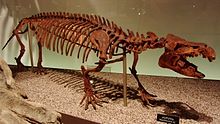
Skeletal reconstruction of Moeritherium

Teeth of Chilgatherium with two to three ridges
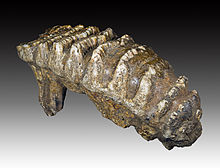
Tooth of Stegodon with up to nine bars
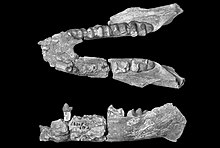
lower jaw of Arcanotherium, here all teeth are in use at the same time (vertical tooth change)
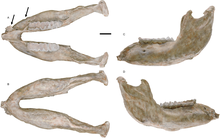
lower jaw of mammoth, here only a few teeth are in use at the same time (horizontal tooth change)

Structure of proboscidean teeth with important topographical reference points; A: upper left molar of Loxodonta, B: lower right molar of Gomphotherium, each posterior tooth
.jpg)
African elephant (Loxodonta africana)

Skull of Elephas in lateral (left) and frontal (right) view; skull and mandible are short and high
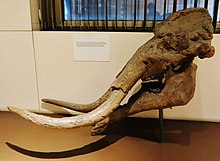
skull of Choerolophodon; skull and mandible are long and low

skull of Phiomia with original short tusks in all four jaw halves
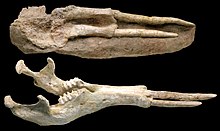
Lower jaw of Tetralophodon with developed tusks
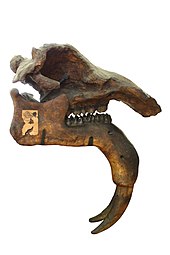
Skull of Deinotherium with tusks in the lower jaw

Skeletal reconstruction of Stegodon
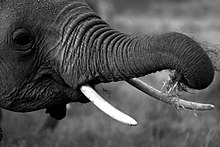
Trunk of an African elephant grabbing a bite

Trunk ends of various elephant species. Left: African elephant, middle: Asian elephant, right: Woolly mammoth.

Hair remains of the woolly mammoth
Distribution
Today's elephants are distributed in the largely tropical landscapes of sub-Saharan Africa and South, Southeast and East Asia. Their habitat is diverse and, depending on the species, includes dense tropical forests, open savannah and bush areas, and desert-like regions. The origin of the group is most likely in Africa, where it can be traced for the first time in the Paleocene, about 60 million years ago. At that time, the continent formed a common landmass with the Arabian Peninsula, but was not yet connected to other parts of the world by land bridges. Such land bridges were not formed until the Lower Miocene, more than 20 million years ago, when the Tethys Ocean to the north closed, creating a link to present-day Eurasia. Among the first emigrants were the Mammutidae and the Gomphotheriidae, which first set foot on Eurasian soil. Some representatives, such as Zygolophodon or Gomphotherium, also reached the North American continent via northern Asia, where independent lines of development then emerged. The first emigrants were followed by the Deinotheriidae, but they did not spread as far as the Mammutidae and Gomphotheriidae, but remained restricted to Eurasia. The first wave of emigration took place about 20 to 22 million years ago. The appearance of proboscideans outside of Africa is referred to as the Proboscidean datum event, although this event, originally thought to be singular, consisted of at least half a dozen separate phases according to recent studies. In the course of the formation of the Isthmus of Panama and the emergence of a closed American landmass in the Pliocene 3 million years ago, the Great American Faunal Exchange occurred, as a result of which some representatives of the Gomphotheriidae also colonized South America.
The proboscideans were thus once widespread over a large part of the Old and New Worlds, only the Australian and Antarctic continents and most of the islands far from the mainland, such as Madagascar and New Guinea, they never reached. Their habitat, however, not only included the tropical landscapes as in the case of today's representatives, it extended far north into the Arctic region, especially in the Pleistocene. As a rule, the various proboscideans used lowlands as habitats, some members such as Cuvieronius had additionally developed mountainous highlands. Some coastal islands were also reached, where the proboscideans then formed typical dwarf forms. Until the late Pleistocene the proboscideans were distributed with several families over America, Eurasia and Africa. Today they are only found with one family in Africa and South Asia in the form of the elephants.
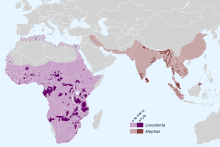
Distribution of today's elephants
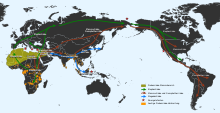
Dispersal of the proboscideans against the background of today's world map; the deinotheria that colonized Eurasia from Africa are omitted.
Questions and Answers
Q: What does the term Proboscidea mean?
A: Proboscidea means "trunked beast".
Q: What is the only family of living animals in the order Proboscidea?
A: The only family of living animals in the order Proboscidea is Elephantidae, which includes elephants.
Q: How many living species of elephants are there?
A: There are three living species of elephants: African forest elephant, African bush elephant, and Asian elephant.
Q: Were there more species of proboscideans during the last ice age?
A: Yes, during the period of the last ice age there were more species, including a number of species of the elephant-like mammoths and mastodons.
Q: When did the oldest proboscidean date from?
A: The oldest proboscidean dates from the early Palaeogene period, over 50 million years ago.
Q: What were the adaptations to various kinds of vegetable food that the evolution of elephant-like animals mainly concerned?
A: The adaptations to various kinds of vegetable food that the evolution of elephant-like animals mainly concerned were the proportions of the cranium and jaw and the shape of the tusks and molar teeth.
Q: What were the adaptations to various kinds of vegetable food for?
A: The adaptations to various kinds of vegetable food were for the elephant-like animals to be able to obtain and process the different types of vegetation available to them.
Search within the encyclopedia


